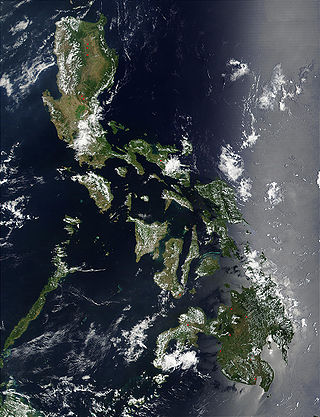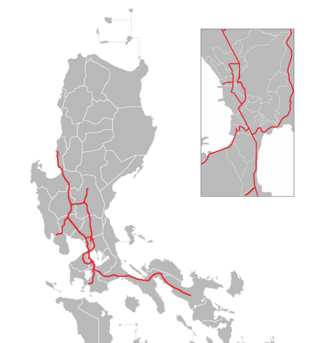Related Research Articles

The Philippines is an archipelago that comprises 7,641 islands with a total land area of 300,000 square kilometers (115,831 sq mi). It is the world's fifth largest island country. The eleven largest islands contain 95% of the total land area. The largest of these islands is Luzon at about 105,000 square kilometers (40,541 sq mi). The next largest island is Mindanao at about 95,000 square kilometers (36,680 sq mi). The archipelago is around 800 kilometers (500 mi) from the Asian mainland and is located between Taiwan and Borneo.

Transportation in the Philippines covers the transportation methods within this archipelagic nation of over 7,500 islands. From a previously underdeveloped state of transportation, the government of the Philippines has been improving transportation through various direct infrastructure projects, and these include an increase in air, sea, road, and rail transportation and transport hubs.

Central Luzon, designated as Region III, is an administrative region in the Philippines, primarily serving to organize the 7 provinces of the vast central plains of the island of Luzon, for administrative convenience. The region contains the largest plain in the country and produces most of the country's rice supply, earning itself the nickname "Rice Granary of the Philippines". Its provinces are: Aurora, Bataan, Bulacan, Nueva Ecija, Pampanga, Tarlac and Zambales. Pangasinan was formerly a province of Central Luzon before President Marcos signed Presidential Decree No. 1, 1972, incorporating it into Ilocos Region. Additionally, the province of Aurora was part of the defunct political region Southern Tagalog when the region was divided into Calabarzon and Mimaropa, upon the issuance of Executive Order No. 103, dated May 17, 2002, by then-President Gloria Macapagal Arroyo, which transferred Aurora to Central Luzon.

Clark International Airport, known as Diosdado Macapagal International Airport from 2003 to 2012, is an international airport covering portions of the cities of Angeles and Mabalacat within the Clark Freeport Zone in the province of Pampanga, Philippines. It is located 80 kilometers (50 mi) northwest of Manila. It is accessible through the Subic–Clark–Tarlac Expressway (SCTEX).

Tarlac City, officially the City of Tarlac, is a 1st class component city and capital of the province of Tarlac, Philippines. According to the 2020 census, it has a population of 385,398 people.

One of the most dynamic and fastest growing sectors in the Philippines is the information technology–business process outsourcing (IT-BPO) industry. The industry is composed of eight sub-sectors, namely, knowledge process outsourcing and back offices, animation, call centers, software development, game development, engineering design, and medical transcription. The IT-BPO industry plays a major role in the country's growth and development.

Philippine Rice Research Institute (PhilRice) is a government corporate entity attached to the Department of Agriculture created through Executive Order 1061 on November 5, 1985 to help develop high-yielding and cost-reducing technologies for farmers.

The Subic–Clark–Tarlac Expressway (SCTEX), signed as E1 and E4 of the Philippine expressway network and R-8 of the Metro Manila arterial road network, is controlled-access toll expressway in the Central Luzon region of the Philippines. From its northern terminus in Tarlac City to its southern terminus at Tipo in Hermosa, Bataan, the SCTEX serves as one of the main expressways in Luzon. The expressway is also connected to the Central Luzon Link Expressway, North Luzon Expressway, Tarlac–Pangasinan–La Union Expressway, and the Subic Freeport Expressway. The SCTEX is the country's longest expressway at 93.77 kilometers (58.27 mi). The Subic–Clark–Tarlac Expressway was constructed to provide a more efficient transport corridor between Subic Bay Freeport, Clark, and the Central Techno Park in Tarlac, foster development on the municipalities served, and connect major infrastructures such as the Subic Seaport and Clark International Airport.
The super regions of the Philippines are an informal and de facto defunct grouping of parts of regions and provinces of the Philippines based on their economic strengths. According to Executive Order No. 561, which establishes these regions,
"[These] groupings neither supersede current political boundaries nor alter the regional development councils as established by existing laws and issuances."

The following outline is provided as an overview of and topical guide to the Philippines:

Clark, officially known as the Clark Freeport and Special Economic Zone (CFEZ), refers to an area in Central Luzon, Philippines.
The Philippines Central Conference of the United Methodist Church is a collection of annual conferences of the United Methodist Church in the Philippines that are organised much like jurisdictional conferences in the United States. The Philippines Central Conference is considered a member church of the World Methodist Council, and a "Central Conference" of the world-wide United Methodist Church. It is also a member of the Christian Conference of Asia and the National Council of Churches in the Philippines as The United Methodist Church in the Philippines, representing the denomination as its Philippine counterpart.

The Commission on Information and Communications Technology (CICT) (Filipino: Komisyon sa Teknolohiyang Pang-impormasyon at Pangkomunikasyon) was the primary policy, planning, coordinating, implementing, regulating, and administrative entity of the executive branch of the Philippine Government that would promote, develop, and regulate integrated and strategic information and communications technology (ICT) systems and reliable and cost-efficient communication facilities and services.

Historical markers are installed by the National Historical Commission of the Philippines (NHCP) in the Philippines and places abroad that signify important events, persons, structures, and institutions in Philippine national and local histories. The plaques themselves are permanent signs installed by the NHCP in publicly visible locations on buildings, monuments, or in special locations. Local municipalities and cities can also install markers of figures and events of local significance. Though they may have the permission of the NHCP, these markers are barred from using the seal of the Republic of the Philippines.
The Lingayen–Lucena corridor is the part of Luzon in the Philippines, between Lingayen to Lucena, comprising the province of Pangasinan, and the regions of Central Luzon, Metro Manila, and Calabarzon, where national elections are claimed to be won. The corridor comprises about 40% of the vote.

The Solid North refers to the regional voting bloc of the northern provinces of the Philippines for politicians of Ilocano descent, more particularly the Marcos family and their allies, and also economic issues affecting the Ilocanos in general such as the tobacco industry. Often included in Solid North are the provinces in the Ilocos Region, Cordillera Administrative Region (CAR), and Cagayan Valley.

Philippine Economic Zone Authority (PEZA), formerly known as Export Processing Zone Authority (EPZA), is a government agency in the Philippines attached to the Department of Trade and Industry created to help promote investments in the export-oriented manufacturing industry into the country by assisting investors in registering and facilitating their business operations and providing tax incentives. PEZA also assists investors who locate in service facilities inside selected areas in the country which are usually business process outsourcing and knowledge process outsourcing firms. Other activities also eligible for PEZA registration and incentives include establishment and operation within special economic zones for tourism, medical tourism, logistics and warehousing services, economic zone development and operation and facilities providers.
The Malacañang of the South, also known as the Presidential Guest House in Davao or Panacañang, is a presidential guest house in Panacan, Davao City that serves as the Philippine President's official residence in Mindanao. It is located in the compound and office complex of the Department of Public Works and Highways (DPWH) Davao Region.

The Philippine expressway network, also known as the High Standard Highway Network, is a controlled-access highway network managed by the Department of Public Works and Highways (DPWH) which consists of all expressways and regional high standard highways in the Philippines.
References
- 1 2 3 Symaco, Lorraine (2012). "Higher Education in the Philippines and Malaysia: the Learning Region in the Age of Knowledge-based Societies". Journal of International and Comparative Education: 40–51.
- ↑ Macapagal-Arroyo, Gloria. "Sixth State of the Nation Address, July 24, 2006". The Official Gazette.
- ↑ Akhtar, Shahid; Arinto, Patricia, eds. (2009). Digital review of Asia Pacific : 2009-2010 (4th ed.). New Delhi: IDRC, Orbicom, and Sage. p. 304. ISBN 978-81-321-0084-3.
- 1 2 Palisada, Stanley. "The Light and Shade of the Cyber Corridor". ABS-CBN News.
- 1 2 3 "Executive Order No. 561". The LawPhil Project. Retrieved 11 July 2017.
- ↑ "Arroyo kicks off 'cyber corridor' tour in Pampanga". 1 February 2010. Retrieved 15 July 2017.
- 1 2 Macapagal-Arroyo, Gloria. "PRESIDENT GLORIA MACAPAGAL ARROYO'S SPEECH DURING THE CYBER CORRIDOR NATIONAL CAPITAL REGION TOUR: VISIT TO JOSE RIZAL UNIVERSITY (JRU)". Wayback Machine. Archived from the original on 7 April 2010. Retrieved 15 July 2017.
{{cite web}}: CS1 maint: bot: original URL status unknown (link) - ↑ "10 'next wave' cities in PH named". 30 March 2016. Retrieved 15 July 2017.
- ↑ "Top 10 Next Wave Cities™ 2016 named". IBPAP. Retrieved 15 July 2017.
- ↑ "Top 10 Next Wave Cities™ 2016 named". IBPAP. Retrieved 15 July 2017.